Chapter 4 - The Language of Chemistry Exercise 56
Question 1
What do you understand by the terms symbol and formula?
Solution 1
Symbol - It is the short form or abbreviation used for the name of an element. It represents one atom of that element.
Formula - Formula of a compound represents the composition of a molecule of the substance in terms of the symbols of the elements present in the molecule.
Formula - Formula of a compound represents the composition of a molecule of the substance in terms of the symbols of the elements present in the molecule.
Question 2
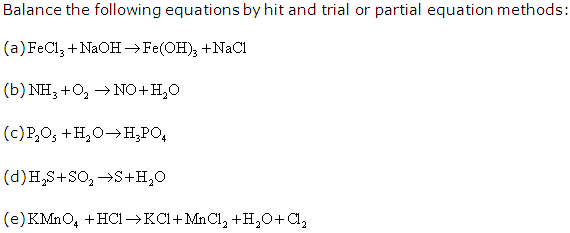
Solution 2
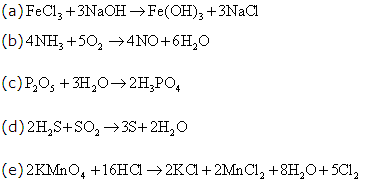
Question 3
What do the symbolsH2, O4 and S mean in the formula H2SO4?
Solution 3
H2 means hydrogen, O4 means oxygen and S means sulphur in the formula of H2SO4.
Question 4
An element for 'Z' forms an oxide ZO3.
(a) What is the valency of the element Z?
(b) What will be the formula of the fluoride of Z?
(a) What is the valency of the element Z?
(b) What will be the formula of the fluoride of Z?
Solution 4
(a) The highest valency of the element Z is six.
(b) The formula of the fluoride of Z will be ZF6.
(b) The formula of the fluoride of Z will be ZF6.
Question 5
An element 'X' forms the following compounds with hydrogen, carbon and oxygen: H2X, CX2, XO2, XO3
State the three valencies of element 'X'. Which are illustrated by these compounds?
State the three valencies of element 'X'. Which are illustrated by these compounds?
Solution 5
The three valencies of element are-
(i) Two-Since the element X combines with two hydrogen to form H2X and two atoms of X combines with one carbon to form CX2.
(ii) Four-Since the element X combines with two oxygen to form XO2.
(iii) Six-Since the element X combines with three oxygen to form XO3.
(i) Two-Since the element X combines with two hydrogen to form H2X and two atoms of X combines with one carbon to form CX2.
(ii) Four-Since the element X combines with two oxygen to form XO2.
(iii) Six-Since the element X combines with three oxygen to form XO3.
Question 6
Explain the term variable valency. Why some elements show variable valency, give examples.
Solution 6
Variable valency - Some elements are capable of showing more than one valency in their compounds called variable valency.
Some elements show variable valency i.e. more than one valency since these elements have more than one common valency state.
Some elements show variable valency i.e. more than one valency since these elements have more than one common valency state.
Question 7
What is a chemical formula? What is the rule for writing a formula correctly?
Solution 7
Chemical formula - It represents the composition of a molecule of the substance in terms of the symbols of the elements present in the molecule. The rule for writing the formula is criss-cross method.
(i) The positive and negative radicals are represented by their symbols and written side by side with the correct valency written below each.
(ii) The valencies are divided by their highest common factor if any to get the simplest ratio.
(iii) These numbers are then interchanged and written as subscripts.
(i) The positive and negative radicals are represented by their symbols and written side by side with the correct valency written below each.
(ii) The valencies are divided by their highest common factor if any to get the simplest ratio.
(iii) These numbers are then interchanged and written as subscripts.
Question 8
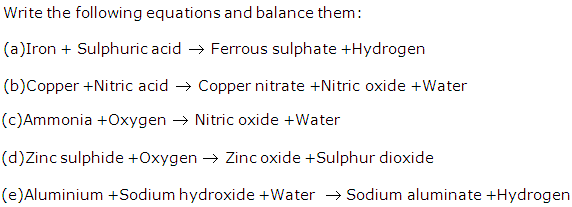
Solution 8
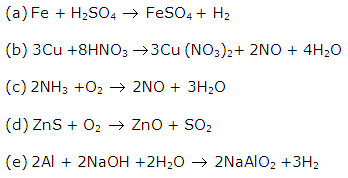
Question 9
Name the following compounds:
(a) NaHCO3
(b) Na3Fe(CN)6
(c) Mn3(BO3)2
(d) Ca3(PO4)2
(e) K2MnO4
(a) NaHCO3
(b) Na3Fe(CN)6
(c) Mn3(BO3)2
(d) Ca3(PO4)2
(e) K2MnO4
Solution 9
(a) Sodium hydrogencarbonate
(b) Sodium hexacyanoferrate(III)
(c) Manganese(II) borate
(d) Calcium phosphate
(e) Potassium manganate(VI)
(b) Sodium hexacyanoferrate(III)
(c) Manganese(II) borate
(d) Calcium phosphate
(e) Potassium manganate(VI)
Question 10
What is the difference between Co and CO?
Solution 10
Co stands for cobalt which is an element while CO stands for carbon monoxide which is a compound.
Question 11
What is radical? Give two examples of monovalent and trivalent radicals.
Solution 11
Radical-
A radical is an atom or a group of atoms of same or different elements that behaves in the manner of positive or negative ion. Radicals have their own combining power(valency) and chemical formulae.
Examples-
Monovalent radicals -H-,OH-,Cl-,NO3-,H+,Na+,K+,NH4+
Trivalent radicals-PO43- ,Fe(CN)63-,AsO3 3-,N3-,Fe3+,Al3+,Bi3+,Au3+
A radical is an atom or a group of atoms of same or different elements that behaves in the manner of positive or negative ion. Radicals have their own combining power(valency) and chemical formulae.
Examples-
Monovalent radicals -H-,OH-,Cl-,NO3-,H+,Na+,K+,NH4+
Trivalent radicals-PO43- ,Fe(CN)63-,AsO3 3-,N3-,Fe3+,Al3+,Bi3+,Au3+
Question 12
Write the formula for the following compounds.
(a) Calcium carbonate
(b) Magnesium sulphate
(c) Ferric sulphate
(d) Calcium bicarbonate
(e) Cuprous iodide
(f) Potassium dichromate
(g) Potassium permanganate
(h) Sodium sulphate
(i) Magnesium nitrate
(j) Calcium phosphate
(a) Calcium carbonate
(b) Magnesium sulphate
(c) Ferric sulphate
(d) Calcium bicarbonate
(e) Cuprous iodide
(f) Potassium dichromate
(g) Potassium permanganate
(h) Sodium sulphate
(i) Magnesium nitrate
(j) Calcium phosphate
Solution 12
(a) CaCO3
(b) MgSO4
(c) Fe2 (SO4)3
(d) CaHCO3
(e) CuI
(f) K2Cr2O7
(g) KMnO4
(h) Na2SO4
(i) Mg (NO3)2
(j) Ca3 (PO4)2
(b) MgSO4
(c) Fe2 (SO4)3
(d) CaHCO3
(e) CuI
(f) K2Cr2O7
(g) KMnO4
(h) Na2SO4
(i) Mg (NO3)2
(j) Ca3 (PO4)2
Question 13
What are the modifications made in a chemical equation to overcome the limitations of it in providing information?
Solution 13
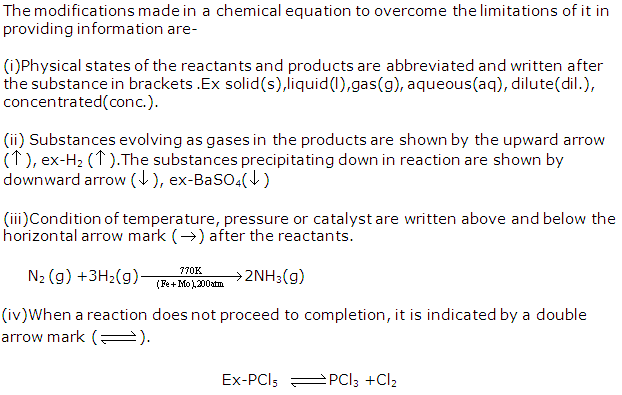
Question 14
What do you understand by (a) Anion, (b) Cation ?
Solution 14
(a) Anion - Negatively charged radicals are termed as anions.
(b) Cation - Positively charged radicals are termed as cations.
(b) Cation - Positively charged radicals are termed as cations.
Question 15
What are the disadvantages associated with hit and trial method of balancing the equations.
Solution 15
Disadvantages associated with hit and trial method of balancing of equations-
(i) It is tedious and takes a long time.
(ii) The method is rather difficult for balancing such equations which contain the same element being repeated in a number of compounds.
(iii) It does not give any information regarding the mechanism of the reaction.
(i) It is tedious and takes a long time.
(ii) The method is rather difficult for balancing such equations which contain the same element being repeated in a number of compounds.
(iii) It does not give any information regarding the mechanism of the reaction.
Question 16
(a) Define the term valency.
(b) Arrange the following elements in the increasing order of their valencies : phosphorous, helium, carbon, sodium, magnesium.
(b) Arrange the following elements in the increasing order of their valencies : phosphorous, helium, carbon, sodium, magnesium.
Solution 16
(a) Valency - The combining capacity of an element is called its valency.
(b) Helium < Sodium < Magnesium < Carbon < Phosphorous
(b) Helium < Sodium < Magnesium < Carbon < Phosphorous
Question 17
Which law govern a completely balanced equation?
Solution 17
Law of conservation of matter governs a completely balanced equation. It states that "matter can neither be created nor destroyed."
Question 18
What does a symbol signify?
Solution 18
A symbol signifies one atom of that element.
Question 19
What are the latin name of iron, tin, lead, sodium, potassium and mercury?
Solution 19
Latin names of the following compounds are-
Iron - Ferrum
Tin - Stannum
Lead - Plumbum
Sodium - Natrium
Potassium - Kalium
Mercury - Hydragyrum
Iron - Ferrum
Tin - Stannum
Lead - Plumbum
Sodium - Natrium
Potassium - Kalium
Mercury - Hydragyrum
Question 20
What is balanced chemical equation?
Solution 20
The equation in which the total number of atoms of each element in the reactants, on the left side of the equation is same as the number of atoms in the products formed, on the right side of the equation is called as balanced chemical equation.
Question 21
Write down balanced chemical equation, giving as much information as possible, for the following reactions.
(a) A piece of magnesium, when burnt in nitrogen, forms solid magnesium nitride.
(b) A piece of potassium violently reacts with water to form an aqueous solution of potassium hydroxide and to liberate hydrogen.
(a) A piece of magnesium, when burnt in nitrogen, forms solid magnesium nitride.
(b) A piece of potassium violently reacts with water to form an aqueous solution of potassium hydroxide and to liberate hydrogen.
Solution 21

Question 22
What information is conveyed by a chemical equation?
Solution 22
A chemical equation gives information about-
(i) What substances enter into a given reaction (reactants) and what products are formed as a result of the reaction.
(ii) The quantities of the reactants and the product formed.
(iii) The optimum conditions of temperature and pressure.
(i) What substances enter into a given reaction (reactants) and what products are formed as a result of the reaction.
(ii) The quantities of the reactants and the product formed.
(iii) The optimum conditions of temperature and pressure.

0 comments:
Post a Comment